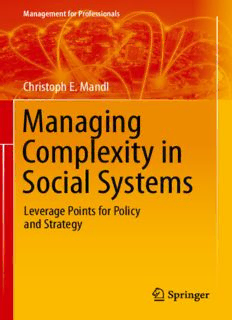Table Of ContentManagement for Professionals
Christoph E. Mandl
Managing
Complexity in
Social Systems
Leverage Points for Policy
and Strategy
Management for Professionals
Moreinformationaboutthisseriesathttp://www.springer.com/series/10101
Christoph E. Mandl
Managing Complexity
in Social Systems
Leverage Points for Policy and Strategy
ChristophE.Mandl
UniversityofVienna
Mandl,Lüthi&Partner
Vienna,Austria
ISSN2192-8096 ISSN2192-810X (electronic)
ManagementforProfessionals
ISBN978-3-030-01643-2 ISBN978-3-030-01645-6 (eBook)
https://doi.org/10.1007/978-3-030-01645-6
LibraryofCongressControlNumber:2018961015
#SpringerNatureSwitzerlandAG2019
Thisworkissubjecttocopyright.AllrightsarereservedbythePublisher,whetherthewholeorpartofthe
materialisconcerned,specificallytherightsoftranslation,reprinting,reuseofillustrations,recitation,
broadcasting,reproductiononmicrofilmsorinanyotherphysicalway,andtransmissionorinformation
storageandretrieval,electronicadaptation,computersoftware,orbysimilarordissimilarmethodology
nowknownorhereafterdeveloped.
Theuseofgeneraldescriptivenames,registerednames,trademarks,servicemarks,etc.inthispublication
doesnotimply,evenintheabsenceofaspecificstatement,thatsuchnamesareexemptfromtherelevant
protectivelawsandregulationsandthereforefreeforgeneraluse.
The publisher, the authors and the editors are safe to assume that the advice and information in this
bookarebelievedtobetrueandaccurateatthedateofpublication.Neitherthepublishernortheauthorsor
theeditorsgiveawarranty,expressorimplied,withrespecttothematerialcontainedhereinorforany
errorsoromissionsthatmayhavebeenmade.Thepublisherremainsneutralwithregardtojurisdictional
claimsinpublishedmapsandinstitutionalaffiliations.
ThisSpringerimprintispublishedbytheregisteredcompanySpringerNatureSwitzerlandAG
Theregisteredcompanyaddressis:Gewerbestrasse11,6330Cham,Switzerland
“No areas of human life are more in need of the tools of system modeling and
complexitysciencethanbusiness,governmentandsocialservices,ingeneral.Inthis
stunning volume, Christoph Mandl offers a world-class introduction to what these
tools actually are and how they can be used to address questions and problems of
everydaylife.ThebestpartisthatMandltakestheacademicmysteryoutofsystem
science, presenting the field in a form and style that is accessible to just about
everyone.Readit!”
—JohnCasti,FounderofX-EventDynamics,LLC,SanJose,CA
“This book clearly tells the story how to deal with system’s complexity in social
systems by using the smart language of stock and flow diagrams. Weak spots and
leverage points in the development of society and economy are addressed. The
reader is supplied by a number of clear and easy to follow archetypes which
constitutethebasisofsomanydynamicsystems.”
—ManfredGronalt,ProfessorattheUniversityofNaturalResourcesandLife
SciencesVienna
“Managing complexity in social systems is a challenge for both professionals and
academicians.Themainobstacleistime:Learningbyexperienceisonlypossibleif
thetime interval betweencauseandeffect isshort,butifcause andeffectsareina
circularrelationship,feedbacksaredelayedthencontrolisnotobviousatall—it’sa
“complextask”.Understandingthesephenomenaformthetopicofthisbookwritten
in,whattheauthorcalls,“semasiographic”languageforbotheducatedmanagersand
students of business analytics. The system behavior casted in stock and flows
diagram provides an intuitive interface between qualitative and quantitative
reasoning about dynamics by using “archetypical” stylized models. Learning takes
placewhileyouthinkaboutinterveninginsuchasystemwhatisbyfaranontrivial
task—thisbookhelpstofindyourway!”
—Hans-JakobLüthi,ProfessorEmeritusatETHZurich
“Thisbooklooksattheworldfromadifferent,yetveryeffectivevantagepoint:the
systemicperspective.Anyoneneedstoandcanimprovehisorherunderstandingof
systems—social, ecological, economic, etc., and will benefit from the systemic
approach. The main question here is: “What are the structures that generate the
behavior of the system in focus?” The author delivers a perfect introduction to
systemicthinking—unorthodox,insightfulandpractical.”
—MarkusSchwaninger,UniversityofSt.Gallen,Switzerland
“Giventherapidlychangingcomplexityofsocietalsystemsandthecommonthread
of organizations ‘doing more of the same with less effect’ in a resource-scarce
environment, this book is not just timely, but necessary. A book of this nature,
with topics such as strategic behavior and operational challenges that a decision
makerwhoisresource-strickenwhilestrivingforsustainabledevelopmentcanrelate
to,isanopportuneandworthwhileendeavor.”
—ChristianStary,ProfessorattheJohannesKeplerUniversityLinz
“A most inspiring approach to simulate the complex socioeconomic dynamics of
managerialsystemssuccessfullyapplyingForrester’sStockandFlowconcept.”
—HugoTschirky,ProfessorEmeritusatETHZurich
To my wife, Hanna
my children, Judith, and Ruth
my grandchildren, Fjor, Lucia, and Leander
and in memory of
my brother Gerhard, 1941–2018
Foreword
Alreadybeforetheyear2000myspeechesincludedtheforecast,“Everyoneinthis
audience will see more change over the next 25 years than you have experienced
duringthepast100.”ThatwasamomentousideaforEuropeanaudiences,giventhe
vast changes in every sphere of their lives since 1900. However, observing the
acceleratingpaceofeventsastheyunfoldin2018,Ibelievemypredictionswillbe
justified.Despitethemountingchaos,wearestillonlyintheveryearlyphasesofan
exponentialchangeprocess.
Changesarecomingineveryaspectoflife—political,economic,environmental,
technological,andpsychological.Theyarebeingdrivenbyclimatechange,automa-
tion, migration, debt, the growing reliance on force to resolve disputes, and many
otherfactors.Noneofuswillbeabletoescapetheeffectsoftheseforces.Butsomeof
uswillflounderwhileotherswillflourish.Theindividualsandorganizationswhoare
outstandinglysuccessfulinthecomingdecadeswillnotbethosewhotrytopredict
thefuture.Ibelievethatisimpossible.Theywillbetheoneswhotrytoperceivethe
underlyingsourcesofchangeandtomanagethedynamicsoftheirinteractionwith
theenvironment.Nooneyetknowshowtodothesethingsverywell.ButChristoph
Mandl’s gives us all a wonderful boost toward mastery. He has been a student,
manager,researcher, andteacher.He providesusinan accessible text many ofthe
insightshehasgainedfromover50yearsofprofessionaleffort.
His book uses graphics rather than mathematics to explain the causes and
consequences of behavior. After an excellent introduction to the basic tools of
system dynamics, he describes 11 common system malfunctions. His text is an
importantcontributiontoanemergingfieldofthought.
Ihaveenjoyedandbenefittedfromreadingthistext;youwillalso.
Durham,NH,USA DennisL.Meadows
July2018
ix
Contents
1 Prelude:ScientificJourneyintoaStrangeParadigm. . . . . . . . . . . . 1
PartI FromLogictoCircularCausality
2 PerceivingEvents,Patterns,andStructure. . . . . . . . . . . . . . . . . . . 13
3 Homeostasis,Complexity,Emergence,andPurposefulBehavior. . . 23
4 DecisionandForecast:TheCassandraParadox. . . . . . . . . . . . . . . 31
PartII DescribingandUnderstandingDynamicsofSocialSystems
5 Language,Syntax,andSemanticsforDescribingDynamics
ofSystems. . . . . . . . . . . . . . . . . . . . . . . . . . . . . . . . . . . . . . . . . . . . 41
6 ConfusingStockswithFlows:TheCarbonCreditFallacy. . . . . . . . 59
7 LeveragePointsasTechnologytoChangeProblematicDynamics. . . 67
8 SensitivityandUncertainty:LocustPlaguesandPriceDynamics
ofCommodities. . . . . . . . . . . . . . . . . . . . . . . . . . . . . . . . . . . . . . . . 81
9 GenericStructures,SystemsArchetypes,andTheories. . . . . . . . . . 91
PartIII ManagingIntraorganizationalPhenomena
10 ShiftingtheBurden:WhenOrganizationsBecomeAddicted. . . . . . 97
11 AccidentalAdversaries:TheEnigmaofSustainedCooperation. . . 107
12 Adaptation:DriftingGoals,InvisibleHand,andBreastfeeding. . . . 113
13 LimitstoGrowth:NetworkEffectandAttractivenessPrinciple. . . 121
14 GrowthandUnderinvestment:AligningPerformance
andResources. . . . . . . . . . . . . . . . . . . . . . . . . . . . . . . . . . . . . . . . . 129
xi
Description:Why do policies and strategies often fail, and what can be done about it? How can complexity be managed in cases where it cannot be reduced? The answers to these questions are anything but trivial, and can only be found by combining insights from complexity science, system dynamics, system theory an

